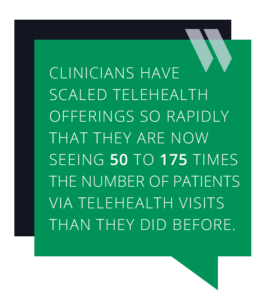Home health telehealth has become a more popular care model among home health agencies (HHA) since the COVID-19 pandemic hit. Once the industry received home health emergency access to telehealth, it embraced this real-time telecommunications technology quite rapidly. Patients and clinicians alike were relieved that telehealth services could help prevent the spread of the virus.
Now it’s becoming the norm for clinicians to deliver care via telehealth visits to check in with patients regularly to track not only coronavirus symptoms but to check vital signs of patients with chronic conditions like heart failure or disease, diabetes, and COPD preventing hospital readmissions.
A daily snapshot of a patient’s health allows clinicians to implement a real-time plan of care and detect downward trends before symptomatic patients become high-risk patients, then adjust Care Management accordingly. We’ve compiled this guide to help the clinicians on your team implement effective home health telehealth to engage patients and improve outcomes.
In this article we cover:
- The benefits of home health teleheath
- Effects of COVID-19 on home health care telehealth
- How to implement your home health telehealth program
- How to secure home health telehealth reimbursement
- Create an effective continuum of care for your home healthcare program
The benefits of home health telehealth
Home health telehealth care is a wide range of healthcare services for an illness or injury that can be received in a patient’s home. According to Medicare.gov, some of the most common skilled home healthcare telehealth services include: wound care for pressure sores or surgical wounds, intravenous or nutrition therapy injections, remote monitoring of illness and unstable biometric status, patient protocol education, as well as home health care education for clinicians in these specialties.
Whether it’s for examining an eye infection or analyzing blood glucose levels, home health telehealth is becoming second nature for care professionals across regions and specialties.
According to Medicare.gov, home healthcare telehealth services are usually less expensive, more convenient, and just as effective as patient care in nursing homes or hospitals and helps prevent readmissions. The Joint Commission and the NIH are publishing a growing body of evidence that suggests an elderly or ill person is less likely to suffer a serious event at home compared to an acute care setting. Home care can also reduce the rate of hospital readmission.
Home health care telemedicine supports aging-in-place by providing everything from 24/7 biometrics monitoring to psycho-social support between in-person visits. It also helps relieve healthcare anxiety for patients who are uncomfortable in healthcare settings.
Delivering healthcare at home supports disadvantaged groups who may not have access to transportation or paid time off to get the healthcare they need. It also offers a window into the social determinants of health that clinicians must address to support wellness. The popular whole-person care model is much easier to implement when healthcare providers leverage telehealth touchpoints and adjust every plan of care to serve a patient’s physical, emotional, spiritual, and environmental needs. The Medicare home health benefit has made this possible for millions of Americans.
Effects of COVID-19 on home health care telehealth

According to McKinsey & Company, clinicians have scaled telehealth offerings so rapidly that they are now seeing 50 to 175 times the number of patients via telehealth visits than they did before. Telehealth reimbursement from the Centers for Medicare & Medicaid Services (CMS) has made this possible.
Before COVID-19, U.S. telehealth players reported annual revenues of approximately $3 billion — mostly in the high-risk patient care segment. They were typically providing on-demand instant telehealth home visits with clinicians who patients did not yet know. With the extension of telehealth beyond virtual urgent care and accelerated adoption, up to $250 billion of U.S. healthcare spending could go to telehealth services.
Home healthcare telemedicine clinicians across the country are looking to accelerate the adoption of Care Management platforms. They’re leveraging real-time telehealth technology — from mHealth apps to connected devices to remote patient monitoring and smart home programs — to provide a continuum of care that integrates in-person visits with home healthcare self-management.
The pandemic has inadvertently aided in that goal, as it caused unprecedented numbers of healthcare providers to bypass crowded or closed hospitals and clinics by offering home health telehealth. Federal and state regulators have enacted a slew of emergency measures that may expand telehealth access and coverage permanently. According to mHealth Intelligence, home healthcare clinicians are lobbying to sway lawmakers to expand virtual care coverage for more conditions and treatments.
The U.S. Department of Health and Human Services is auditing the steps already taken by the Centers for Medicare and Medicaid Services (CMS) to support the COVID-19 response through the use of Section 1135 waivers, which were temporarily amended to allow home health agencies to use telehealth visits in conjunction with in-person visits — offering telehealth reimbursement at the same rate as in-person visit reimbursement. In 2021, the CMS made these changes permanent, providing coverage for HIPAA-compliant telehealth visits under strict conditions.
CMS officials evaluate home healthcare telehealth services provided by home health agencies and nursing homes during the COVID-19 public health emergency (PHE) to determine which skilled services were delivered via telehealth visits and whether they were administered and billed in accordance with Medicare requirements. Auditors then track and investigate overpayments of services that were improperly billed and make appropriate Medicare reimbursement recommendations to the CMS.
How to implement your home health telehealth program
Before implementing a home health telehealth program, make sure your Care team is taking these steps to ensure success and reimbursement in their plan of care:
Comply with home healthcare telehealth regulations
Although rules and regulations are still being debated in Congress as the pandemic wanes, these are some basic guidelines to follow:
- Virtual care check-ins can only be reported if clinicians have established relationships with patients.
- Telemedicine and remote patient monitoring must be requested by patients, but healthcare providers may educate patients about the availability and functionality of these telehealth services.
- Remote patient monitoring (RPM) or other telehealth services must be related to patient-specific needs as identified in the CMS comprehensive assessment.
- Healthcare providers who may not independently bill for evaluations and virtual care visits (i.e. physical therapists, occupational therapists, speech pathologists, and clinical psychologists) may still provide telehealth services when patients request them.
- Covered healthcare providers should deliver care only via telecommunications technology vendors that are HIPAA-compliant — like Skype for Business, Microsoft Teams, Updox, VSee, Zoom for Healthcare, Doxy.me, Google G Suite, Hangouts Meet, Cisco Webex Meetings, Webex Teams, Amazon Chime, GoToMeeting, and Spruce Health Care Messenger.
- There are currently no geographic restrictions on telehealth delivery for home health providers in the U.S.
Check the CMS website periodically for regulatory and legislative updates on home healthcare telehealth services and reimbursement. You’ll also find the latest information on how the Center for Consumer Information and Insurance Oversight (CCIIO) is working with states to establish new healthcare insurance marketplaces to those created by the Affordable Care Act, which first introduced telehealth coverage in 2010.
CMS.gov also offers this home health care advice to clinicians about Medicare Advantage: “Starting in 2020, Medicare Advantage Plans may offer more telehealth benefits than Original Medicare. These virtual care benefits can be available in a variety of places, and you can use them at home instead of going to a healthcare facility. Check with your plan to see what additional telehealth benefits it may offer.”
Source user-friendly home care technology
The primary telehealth barrier for both patients and providers is the technological learning curve. Make sure to choose home health care monitoring devices that your patients and clinicians are comfortable with, and provide thorough directions and training for those who are less savvy about telecommunications technology.
Medical Life Sciences provides a list of core technologies for telehealth:
- Tablets: Medical tablets provide the ability to access home health care telehealth data and consult with patients from any location through a lightweight device — 20% of U.S. hospitals supply tablets for patients to access their medical information with the added enhancements of entertainment apps.
- Personal devices: A successful telehealth infrastructure must be flexible enough to allow patients, caregivers, and healthcare providers to bring their own devices to access telemedicine systems — this will increase the demand for telehealth.
- Software: It’s vital to have an accompanying Telehealth platform that can easily integrate with all current healthcare platforms and hardware components to ensure zero interruptions of Care team workflows. A team-first Care Management platform with a codeless program design and centralized conversations that is easy to scale will streamline clinicians’ workflow to help you focus on real-time patient care.
- IT infrastructure: Hardware and software should be easy to configure in ways that adapt to various healthcare and virtual care environments — clinicians’ telehealth information systems must integrate patient care applications and virtual care data management tools to enable real-time decision-making during home health care telehealth delivery.
- Hardware: Jotform lists these essential home healthcare telehealth tools:
- Remote vital monitoring devices are worn by patients continuously to assess their vitals and send results to your device.
- Virtual stethoscopes record audio of your patient’s heart, lungs, or digestive system and transmit it to your device.
- Wireless scales ensure accurate readings of a patient’s weight to make it easier to correctly prescribe medication and treatment.
- Thermometers record and display a patient’s temperature multiple times a day and send it to your device so you can track changes in their condition.
- Digital otoscopes livestream video and images of your patient’s ear to you and record images for future viewing.
- Pulse oximeters measure oxygen levels — critical for patients who suspect they have COVID-19.
- High-quality cameras for specialists like dermatologists and radiologists can provide higher-resolution images and videos to diagnose conditions.
Once you’ve integrated all these tools and taught both patients and providers to use them, you’ll be ready to launch your home health telehealth program.
Ensure data security
Be aware that video conferencing applications are prone to hacks that compromise patient privacy, as Harvard Medical School researchers explain in December 2020’s Journal of the American Medical Informatics Association. According to HealthTech the potential vulnerabilities of these tools and systems include poorly secured endpoints, networks and IP addresses, as well as uninstalled patches.
These security inadequacies have reduced trust in telehealth technology. According to a CynergisTek survey, 48% of patients are unlikely to use telehealth again if their personal health data is hacked. Amid COVID-19, this could lead patients to seeking an in-person appointment or to skip care altogether — both of which could have a negative effect on patient outcomes.
Make sure you’re using secure remote devices and network access tools. Your remote monitoring devices should support regular software updates, which will ensure patches are installed and security gaps filled. Make sure your medical devices as well as company laptops and smartphones connect only to protected Wi-Fi networks and that your enterprise systems require strong passwords and two-factor authentication.
Just as hospital employees are prepared to respond to a fire or work in inclement weather, they should also know how to proceed in the event of a data breach or ransomware attack. Cybersecurity response plans require regular training and practice. Inform all employees and how to check security settings, how to run a virus scan, and who to call in case of a hack. As remote work and online learning and virtual care become more common, people are becoming more aware of these security measures for home health care telehealth and other uses.
Prepare your Care team
According to Patient Engagement Health IT, 90% of clinicians said they can see the benefits of virtual care, 66% cited access to real-time patient care, 52% noted improved patient satisfaction, and 45% praised better connection with patients and their caregivers. However, only 18% plan on adopting telehealth technology because of reimbursement questions, complex licensing procedures, and costs. Despite these concerns, virtual care adoption will be essential for healthcare organizations, home health agencies, and nursing homes looking to survive in an increasingly competitive healthcare industry.
Clinicians and healthcare administrators must set goals for adopting virtual care and target high-risk patients who need to monitor vital signs and follow in-person visits with virtual visits. They should also assess workforce readiness and engagement, telecommunications technology, telemedicine infrastructure, remote patient monitoring, operations, and clinicians’ workflows. When you’re implementing telemedicine, ensure that your telehealth program caters to healthcare providers’ real-time needs when delivering each health plan and each episode of care.
How to secure home health telehealth reimbursement
CMS.gov currently does not recognize the home healthcare provider as a telehealth provider — instead, it allows primary care clinicians to prescribe home health care telehealth services and manages them for home healthcare agencies. Clinicians and other healthcare practitioners may prescribe and bill for telehealth services, but home health care clinicians may not.
A group of bipartisan senators recently introduced a new version of the Home Health Emergency Access to Telehealth (HEAT) Act. It gives CMS the authority to issue a waiver that would allow for telehealth visits to count toward in-person visits as included on the plan of care only during a public health emergency. The COVID-19 public health emergency is expected to last throughout 2021, so such an action could make a huge difference for home health agencies.
If enacted, the HEAT Act would help clinicians and caregivers at home health agencies meet the rising demand for home health services during a time when the supply of nurses and other in-home care clinicians is at a premium. The bill’s potential passage would also allow home health agencies to conserve personal protective equipment (PPE) and minimize in-person visits during a future pandemic or public health emergency.
Create an effective continuum of care for your home healthcare program
Telemedicine offers a massive opportunity to drastically improve the way clinicians at home health care agencies provide patient-centered virtual care. Regardless of a patient’s condition or a caregiver’s circumstance, there is bound to be a telecommunications technology out there that can help track vital signs in real-time and effectively manage care plans via telehealth programs.
Home health care telemedicine expands access to millions of new patients. Clinicians and other healthcare providers must be educated on virtual care procedures, protocols, and patient-provider relationship-building in real-time via telehealth platforms. Only then will they be empowered to educate patients on self-management via remote patient monitoring and wellness strategies shared during virtual visits. Learn how to prepare your home health Care team for next-generation telehealth — read our Guide to Telehealth.



